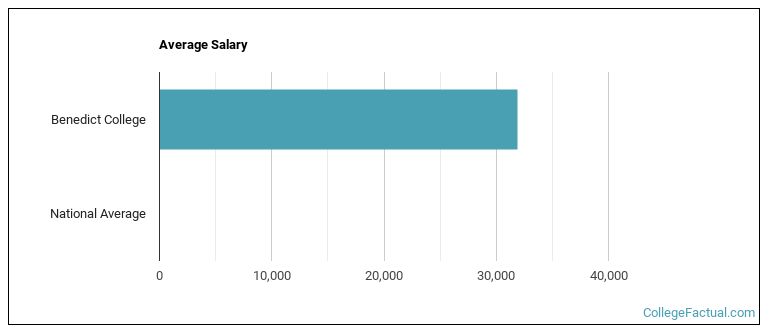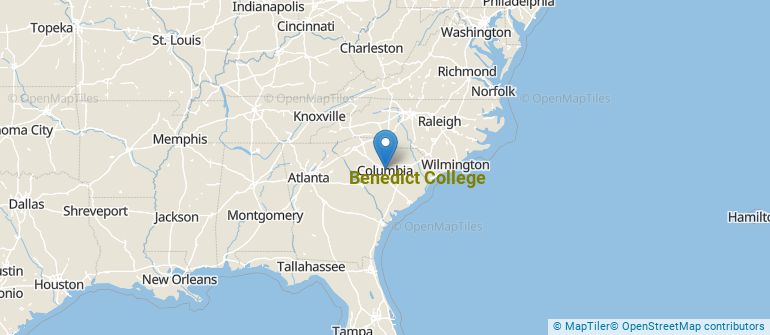 by our College Data Analytics Team
by our College Data Analytics TeamExplore the best ranked schools for the programs you are most interested in.
Benedict College is ranked #2,075 out of 2,152 schools in the nation for overall quality on College Factual's 2025 Best Colleges list. This is an improvement over the previous year, when Benedict College held the #2,174 spot on the Best Overall Colleges list.
Benedict College is also ranked #45 out of 45 schools in South Carolina.
The acceptance rate at Benedict College is a competitive 68%, so make sure you take your application seriously when putting it together. Even leaving out a minor detail could be a reason to move you to the rejection pile.
About 16% of students accepted to Benedict College submitted their SAT scores. When looking at the 25th through the 75th percentile, SAT Evidence-Based Reading and Writing scores ranged between 420 and 520. Math scores were between 400 and 500.
With a student to faculty ratio of 17 to 1, Benedict College is about average in this regard as the nationwide rate is 15 to 1. While this does not translate directly to class size, it's a good indicator of how much time professors will have to spend with their students on a one-on-one basis.
In addition to the student to faculty ratio, some people look at what percentage of faculty members are full-time as a sign of how much time professors will be able to spend with their students. This is because part-time teachers may not be be on campus as much as their full-time counterparts.
The full-time faculty percentage at Benedict College is 67%. This is higher than the national average of 47%.
The freshmen retention rate tells us what percentage of first-year, full-time students choose to continue on to their sophomore year at a particular school. The rate at Benedict College is 65%, which is about average when compared to the national rate of 68%.
The on-time graduation rate is the percent of first-time, full time students who obtain their bachelor's degree in four years or less. This rate is 15% for first-time, full-time students at Benedict College, which is lower than the national rate of 33.3%.
Find out more about the retention and graduation rates at Benedict College.
During the 2017-2018 academic year, there were 1,724 undergraduates at Benedict College with 1,700 being full-time and 24 being part-time.
| $0-30 K | $30K-48K | $48-75 | $75-110K | $110K + |
|---|---|---|---|---|
| $18,145 | $17,085 | $19,258 | $22,814 | $21,120 |
The net price is calculated by adding tuition, room, board and other costs and subtracting financial aid.Note that the net price is typically less than the published for a school. For more information on the sticker price of Benedict College, see our tuition and fees and room and board pages.
Almost 66% of college students who graduated with the class of 2018 took out student loans, but that percentage varies from school to school. At Benedict College, approximately 61% of students took out student loans averaging $6,213 a year. That adds up to $24,852 over four years for those students.

Get more details about the location of Benedict College.

Contact details for Benedict College are given below.
| Contact Details | |
|---|---|
| Address: | 1600 Harden Street, Columbia, SC 29204-1086 |
| Phone: | 803-253-5000 |
| Website: | www.benedict.edu/ |
| Most Popular Majors | Bachelor’s Degrees | Average Salary of Graduates |
|---|---|---|
| Business Administration & Management | 39 | $28,419 |
| General Biology | 30 | $22,805 |
| Health & Physical Education | 29 | NA |
| General Psychology | 22 | $27,620 |
| Communication & Media Studies | 18 | NA |
| Information Science | 18 | NA |
| Public Health | 18 | NA |
| Criminal Justice & Corrections | 18 | $23,838 |
| Accounting | 11 | NA |
| Social Work | 11 | $30,295 |
Online learning options are becoming more and more popular at American colleges and universities. Online classes are great for students who have busy schedules or for those who just want to study on their own time.
In 2022-2023, 1,047 students took at least one online class at Benedict College. This is a decrease from the 1,105 students who took online classes the previous year.
| Year | Took at Least One Online Class | Took All Classes Online |
|---|---|---|
| 2022-2023 | 1,047 | 114 |
| 2021-2022 | 1,105 | 62 |
| 2020-2021 | 1,731 | 1,053 |
| 2018-2019 | 0 | 0 |
If you’re considering Benedict College, here are some more schools you may be interested in knowing more about.
Curious on how these schools stack up against Benedict College? Pit them head to head with College Combat, our free interactive tool that lets you compare college on the features that matter most to you!
Footnotes
*The racial-ethnic minorities count is calculated by taking the total number of students and subtracting white students, international students, and students whose race/ethnicity was unknown. This number is then divided by the total number of students at the school to obtain the racial-ethnic minorities percentage.
References
More about our data sources and methodologies.